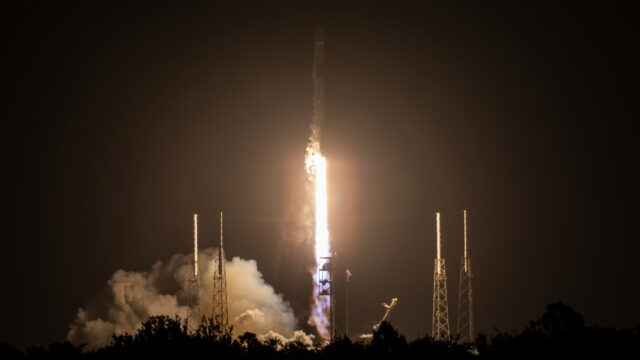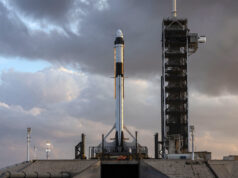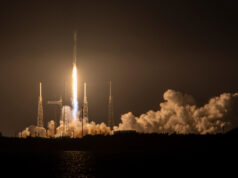
The predawn sky over Florida cracked open not with thunder, but with the controlled fury of a Falcon 9 rocket. From the historic launch complex at Cape Canaveral Space Force Station, SpaceX sent another batch of its Starlink internet satellites climbing towards orbit. This mission, carrying 28 of the flat-panel spacecraft, marks another step in the company’s ambitious plan to build a global broadband network from space.
Beneath the glare of powerful spotlights, the two-stage rocket stood tall against the inky blackness. Inside its nosecone, the payload fairing, were the satellites, stacked neatly, awaiting their ride to space. These aren’t your traditional bulky satellites; they are designed for mass production and deployment, a key factor in building out the vast Starlink constellation. Each one weighs in at several hundred kilograms, packed with advanced technology to beam internet signals down to users on Earth.
The countdown ticked away with precise automation, a familiar rhythm for those who follow the steady cadence of launches from Florida’s Space Coast. Minutes before liftoff, the Merlin engines at the base of the Falcon 9 roared to life, building thrust. The ground around the launch pad vibrated, a deep rumble that could be felt miles away. Then, with a sudden, brilliant flash and a deafening roar, the hold-down clamps released, and the rocket began its ascent.
Slowly at first, then gathering speed, the Falcon 9 pushed against gravity, a fiery spear piercing the atmosphere. The bright orange tail of the exhaust plume stretched out behind it as it climbed higher and higher. Onboard, the 28 Starlink satellites experienced the intense forces of acceleration, a controlled violence necessary to escape Earth’s pull.
The first stage of the Falcon 9, having done its job propelling the rocket through the thickest part of the atmosphere, separated smoothly. It then began its carefully choreographed descent back to Earth. This reusable capability is a cornerstone of SpaceX’s business model, significantly reducing the cost of access to space. The booster performed a series of engine burns to control its re-entry and guide itself towards a waiting autonomous drone ship positioned hundreds of miles off the Florida coast in the Atlantic Ocean.
Meanwhile, the second stage, powered by a single vacuum-optimized Merlin engine, continued to carry the Starlink satellites towards their target orbit. This engine is designed to operate efficiently in the vacuum of space, providing the final push needed to place the satellites precisely where they need to be.
For those watching from the ground, the sight of the second stage continuing its journey after first stage separation is a common but still awe-inspiring part of a SpaceX launch. The bright dot of the second stage engine glowing in the upper atmosphere is visible for several minutes before disappearing over the horizon.
Once the second stage reached the designated altitude and velocity, it released the 28 Starlink satellites. They didn’t deploy all at once in a single clump. Instead, they were carefully dispensed in a sequence, like a deck of cards fanned out, to begin their individual journeys to their operational positions within the constellation. Each satellite would then use its own onboard propulsion system to maneuver into its final orbit and begin its mission.
These 28 satellites join thousands of their predecessors already orbiting Earth. The Starlink constellation operates in a relatively low Earth orbit, much closer than traditional geostationary satellites. This lower altitude is key to providing lower latency – the delay in data transmission – which is crucial for applications like video calls and online gaming.
The goal of Starlink is to provide high-speed internet access to people in areas where traditional broadband infrastructure is unreliable or non-existent. This includes rural communities, remote locations, and even areas affected by natural disasters where ground-based communication systems may be down. Reports from users in various parts of the world highlight the impact Starlink is having, bringing connectivity to places that were previously underserved. Fishermen in remote coastal areas using it to stay connected, families in rural villages accessing online education and healthcare, and emergency responders utilizing it for critical communication are just some examples of how the network is being used.
Building this constellation is a massive undertaking, requiring frequent launches to deploy new satellites and replace older versions as technology improves. Each launch adds more capacity and coverage to the network. The satellites launched on this mission likely incorporate the latest technological advancements, improving performance and reliability.
The recovery of the first stage booster is a critical part of SpaceX’s strategy. After landing on the drone ship, the booster is secured and brought back to shore. It undergoes inspection and refurbishment before being prepared for another flight. This rapid reusability is a significant factor in bringing down the cost per launch, making access to space more affordable. Seeing a Falcon 9 booster land successfully after sending a payload to orbit has become a familiar sight, but it remains a remarkable engineering achievement.
This launch of 28 Starlink satellites is more than just another rocket taking off. It represents continued progress in building a global communication network with the potential to connect millions of people. It’s a demonstration of repeatable, reliable access to space. And for those who watched from Florida, it was a reminder of the power and ambition of modern spaceflight, a spectacle of light and sound against the quiet backdrop of the night. The satellites, now in orbit, begin their work, another set of nodes in the ever-expanding web of connectivity high above us.










